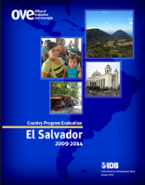Country Program Evaluation: El Salvador (2009-2014)
Date
Jan 2015
This country program evaluation (CPE) was conducted during the preparation of a new country strategy with El Salvador for the 2015-2019 period. The evaluation therefore includes the findings from the strategy in effect from 2010 to 2014 (document GN-2575).
According to the country program evaluations protocol (document RE-348-3), the main goal of the CPE is "to provide information on Bank performance at the country level that is credible and useful, and that enables the incorporation of lessons and recommendations that can be used to improve the development effectiveness of the Bank's overall strategy and program of country assistance."
Accordingly, this CPE aims to analyze the Bank's relationship with the country, from an independent and holistic viewpoint, assessing in particular the program's relevance, efficiency, effectiveness, and sustainability, including both financial and nonfinancial products offered by the Bank during the period under analysis.
This is the third independent evaluation of the country program carried out by OVE. The first (document RE-307) covered the 1992-2004 period, which was characterized by rapid economic growth in the wake of the Chapultepec Peace Accords. The second OVE evaluation (document RE-360) covered the 2004-2008 period; it was marked by the limited results of the ambitious reform program embarked upon in the late 1990s, as well as the political polarization that affected the Bank's program with the country.
As part of this evaluation, the team visited El Salvador on two occasions and interviewed 120 people, including the Governor of the Bank, the Minister of Finance, the Chairman of the Central Reserve Bank of El Salvador, and other top government and central bank officials. The mission also met with representatives of academia and the private sector. Lastly, the team interviewed all the staff at the Bank's Country Office, including the Representative, the chief of operations, sector specialists, fiduciary specialists, and operations analysts.
This evaluation is accompanied by sector annexes on the economy and public finances, the social protection, transportation, water and sanitation, housing and urban development sectors, and a general portfolio analysis annex.
According to the country program evaluations protocol (document RE-348-3), the main goal of the CPE is "to provide information on Bank performance at the country level that is credible and useful, and that enables the incorporation of lessons and recommendations that can be used to improve the development effectiveness of the Bank's overall strategy and program of country assistance."
Accordingly, this CPE aims to analyze the Bank's relationship with the country, from an independent and holistic viewpoint, assessing in particular the program's relevance, efficiency, effectiveness, and sustainability, including both financial and nonfinancial products offered by the Bank during the period under analysis.
This is the third independent evaluation of the country program carried out by OVE. The first (document RE-307) covered the 1992-2004 period, which was characterized by rapid economic growth in the wake of the Chapultepec Peace Accords. The second OVE evaluation (document RE-360) covered the 2004-2008 period; it was marked by the limited results of the ambitious reform program embarked upon in the late 1990s, as well as the political polarization that affected the Bank's program with the country.
As part of this evaluation, the team visited El Salvador on two occasions and interviewed 120 people, including the Governor of the Bank, the Minister of Finance, the Chairman of the Central Reserve Bank of El Salvador, and other top government and central bank officials. The mission also met with representatives of academia and the private sector. Lastly, the team interviewed all the staff at the Bank's Country Office, including the Representative, the chief of operations, sector specialists, fiduciary specialists, and operations analysts.
This evaluation is accompanied by sector annexes on the economy and public finances, the social protection, transportation, water and sanitation, housing and urban development sectors, and a general portfolio analysis annex.



